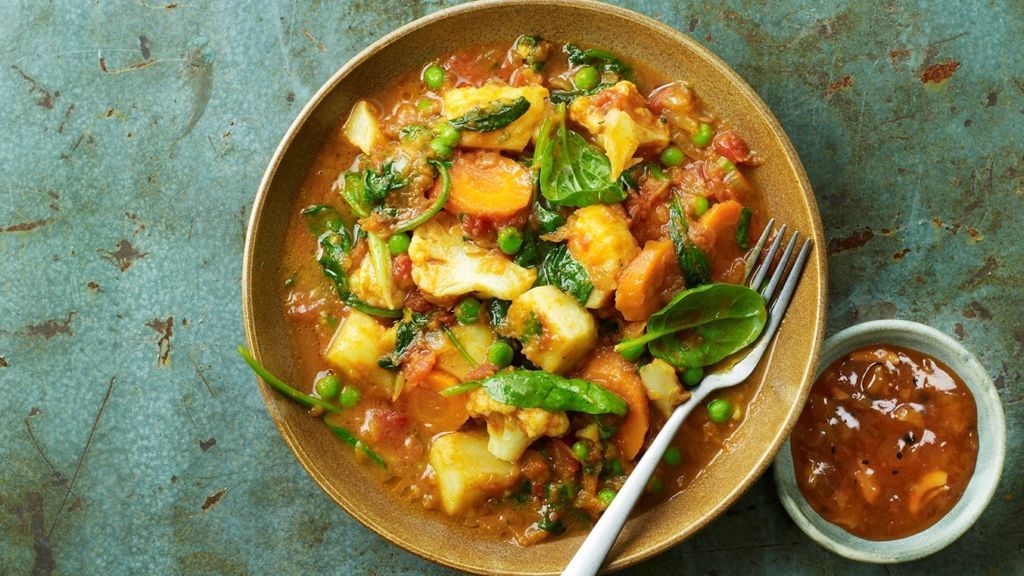Curry vegetable is a healthy dish as it made from various vegetables. It is a flavourful dish that can even entice the meat lover to try it. The combinations of herbs, spices, and vegetables create a savoury and delicious dish. This wholesome meal is served with flat-breads or rice.
What is Curry Vegetable?
Curry vegetable is simply curry paste and vegetables cooked in coconut milk. This dish is so tasty it can even rival meat curries as it contains more spices. The curry paste is made from onion, lemongrass, red chilli, candlenut, and galangal. The spices are blended until it becomes a smooth paste. It is quite a time consuming to prepare curry paste from scratch.
You can make the curry paste from scratch or buy a ready-made curry powder packet available in most markets. There are many types of curry powder, depending on the type of ingredients used in the curry. You can easily add water to the curry powder to create the curry paste.
The common vegetables used in curry vegetables are tofu puffs, long beans, cabbage, potato, carrot, and eggplant. However, it is a versatile dish and goes well with any combinations of vegetables of your choosing. Thus, there are a variety of curry vegetables with different colours and texture available.
The essential ingredient for curry vegetable is coconut milk. The fresh and creamy coconut milk creates a delicious bowl of curry vegetables. Some people may prefer dairy cream or yoghurt to makes its gravy. You can even try our recipe for curry vegetable by clicking here.
History of Curry Vegetable
The term curry originated from the Tamil word ‘kari’. It refers to the sauce or side dish to the rice. Now, the term curry refers to any spicy, sauce-based dishes cooked in South and Southeast Asian styles.
Curry originated from the Indian subcontinent where the spices and herbs used for curry are readily available in that area. There was evidence of the usage of mortar and pestle to pound these spices in around 2600 BCE. The usage of coconut milk in the curry was introduced by the Austronesian peoples to southern India.
Curries were not as spicy as today’s version of curry. In 1510, the Portuguese trading centre in Goa introduced the chilli pepper to India, and thus, the addition of chilli pepper makes the curry spicier than before.
In the 17th century, curry began to spread to England by traders and immigrants. It became even more popular and spread to other countries since then. Many countries have adapted the curry recipe to suit their local preferences and availability of the ingredients.
Varieties of Curry Vegetable
Curry vegetable differs depending on regions, countries, and the availability of ingredients. It is a versatile dish where any combinations of vegetables can create a wonderful dish. It is not just a simple and boring vegetable dish anymore.
The curry can also have different colour and consistency. The colour can be from pale yellow to bright red or even green. There are two types of curry which is ‘wet’ or ‘dry’. The dry curry has very little sauce that only coats the ingredient. For the wet curry, there is a significant amount of gravy.
In Malaysia, there is such a version of curry vegetable called Sayur Lodeh. Sayur Lodeh is a mix of vegetables in coconut milk that has less spice compared to the regular curry. It usually served with nasi impit (compressed white rice) and a popular dish during Raya festival.
Where to find Curry Vegetable in Malaysia
You can easily find this dish at any Mamak or Malay restaurants in Malaysia. During breakfast, it is typically served with roti canai or naan.
You can order Mixed Vegetable Curry from Annapoorani Curry House (Johor Bahru) or Sandalo Healthy Vegetarian (Petaling Jaya). If you want to have roti canai with curry vegetables, order it from Simple Life Healthy Vegetarian (Subang Jaya).
Find more of the Indian cuisine on foodpanda!
